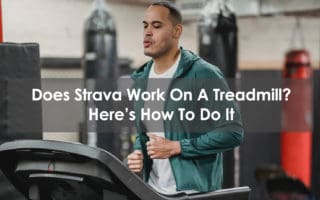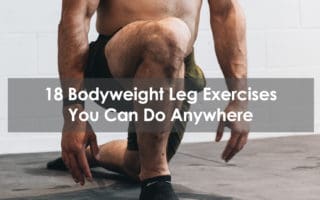Few exercises can hold a candle to the deadlift – there’s a reason it’s one of the most popular choices among professional weightlifters and athletes. The traditional deadlift targets numerous muscle groups and helps build power.
However, there is a variation that specifically targets the typically underdeveloped muscles in your posterior chain; the Romanian deadlift (RDL). This exercise pretty much removes the quadriceps from the equation, instead, it forces the glutes and hamstrings to do most of the work.
That being said, RDLs also put more strain on your lower back, which can lead to injury when they’re not performed correctly. Here are 11 alternatives to the RDL.
1. Single-leg Romanian Deadlifts
How To:
- Stand with your feet hip-width apart and hold a dumbbell in one hand with an overhand grip.
- Slightly bend the knee of your working leg and begin to lower the dumbbell to the ground as you hinge at the hips, keeping your arm extended and your spine neutral. As you do this, lift the non-working leg straight behind you.
- Push through the heel of your working leg and drive through to return to the starting position, squeezing your glutes at the top. Complete all the reps on one side before moving to the other.
- Reps: 8-10 on each leg.
Equipment Used:
- Dumbbell
Why It’s A Great Alternative:
Not only do these target your posterior chain but they also enhance your balance and coordination. Plus, as you’re using less weight, they’re easier on your back than RDLs.
Pro Tip:
Once you feel a stretch in your hamstring when lowering the dumbbell down, that’s when you’ve reached the furthest point and should then start returning to the starting position.
2. Good Mornings
How To:
- Place a barbell onto your upper traps.
- Keeping a slight bend in your knees and a neutral spine, push your hips backwards and hinge to create tension through the hamstrings.
- Keep your chest open as it lowers toward the ground.
- Activate your glutes to drive your hips forward and return to the starting position.
- Reps: 10-12.
Equipment Used:
- Barbell
Why It’s A Great Alternative:
Your hamstrings and glutes are controlling the movement here, so they’re directly targeted by this exercise.
Pro Tip:
Ensure your shoulders are pinched together throughout the exercise as this will keep your chest open.
3. Barbell hip-thrust
How to:
- Find a padded bench or box and sit in front of it with your legs straight out in front, and a barbell across your hips.
- Place your upper back against the padded equipment and bend your knees to bring your feet closer to your glutes.
- Drive your heels down and push your hips upward until they are fully extended.
- Lower under control and repeat.
- 10-12 reps.
Equipment Used:
- Barbell
- Padded bench, box or step
Why It’s A Great Alternative:
- Hip thrusts work a lot of the same muscles as the RDL, without putting too much potential strain on your lower back.
Pro Tip:
Keep your back straight and neutral all the way through this exercise to ensure your lower body is doing all the work.
4. Cable Pull Through
How To:
- Attach the rope handle and place it on the bottom slot in the tower.
- Stand over the rope handle, facing away from the tower, and hold the rope handle with both hands. Keep your feet roughly in line with your hips with your arms extended, your knees bent and your spine neutral.
- Hinge at your hips and lower your chest toward the ground until you feel a stretch in the working muscles (glutes and hamstrings), allowing the tension of the cable to bring your hands between your legs.
- Drive through to an upright position by engaging your glutes until your hips lock.
- Repeat for 12-15 reps.
Equipment Used:
- Cable machine
- Rope handle attachment
Why It’s A Great Alternative:
This exercise doesn’t require much equipment, and it’s very easy to change the weight settings on the cable machine, meaning you can tailor this exercise to your needs. Like the RDL, it’s focusing on your posterior chain meaning your glutes and hamstrings are getting a great workout.
Pro Tip:
Start with a lower weight to ensure your form is correct, then gradually increase this over time. Pay attention to your lower back; if there’s any sort of pain, then stop and reduce the weight, as well as re-assessing your form.
5. Sumo Deadlift
How To:
- Stand in front of a barbell with your feet wider that shoulder-width apart and your toes pointed out at 45-degree angles, toward the weight plates on the bar.
- Hinge your hips back and bend down with your knees to take hold of the bar with a narrow grip and your arms straight. Ensure your knees track over your feet.
- Keeping your back straight, drive up through your feet and legs, bringing the bar up with you to return to a standing position.
- Lock the weight out at the top of the movement by fully engaging your glutes.
- Repeat for 10-12 reps.
Equipment Used:
- Barbell
Why It’s A Great Alternative:
By keeping the spine straight and the spine central, this exercise removes strain from the lower back that usually comes with an RDL, while still hitting your glutes and hamstrings.
Pro Tip:
Ensure the bar is close to your body throughout the exercise, and be sure to avoid letting your chest collapse over it by keeping your gaze forward and your shoulders pinned back.
6. Kettlebell Swing
How To:
- Stand with the kettlebell on the floor slightly in front of you and between your legs, which should be shoulder-width apart.
- Bend slightly at the knees and hinge forward at the hips to grab the kettlebell with both hands, keeping your arms and back straight.
- Lift the kettlebell off the floor and pull it back between your legs to create momentum.
- Drive forward with your hips to swing the kettlebell upward in front of you, to chest height.
- Let the kettlebell swing back down between your legs, under control, to begin the movement again.
- Repeat for 15-20 reps.
Equipment Used:
- Kettlebell
Why It’s A Great Alternative:
This targets your glutes and hamstrings, just like the RDL, but is also a great way of creating power and explosiveness. You can also work toward higher rep ranges to turn this into a cardio workout, as well.
Pro Tip:
Avoid using your upper body to swing the kettlebell – all the power should come from your legs. When you bring the kettlebell down between your legs, make sure your forearms are pushed back against your quads, so you can use your legs to push them upward in the swing.
7. Bodyweight Bridges
How To:
- Lie down on the floor with your knees bent and feet flat.
- Engage your glutes and abs, drive your feet into the floor and lift your hips up.
- Slowly lower your hips back to the floor and then repeat.
- Reps: 12-15.
Equipment Used:
- None
Why It’s A Great Alternative:
These can create a real burn on your glutes, and there’s relatively little chance of injury here as well. As you’re only using your glutes and abs to lift your hips up, those muscle groups are getting a targeted workout.
Pro Tip:
When at the top of the exercise, make a straight line from your shoulders to your knees. Tense your core by trying to pull your belly button toward your spine.
8. Hamstring Leg Curl
How To:
- Sit in the leg curl machine and adjust the height accordingly. If there is one, lock in the pad above your knees.
- Extend your legs straight out and place your feet onto the padded lever. Grab hold of the handles on the machine.
- Pull the lever down with your legs so your knees are bent. Stop once you feel the stretch in your hamstrings and hold for one or two seconds.
- Allow the lever to rise back up, under control, and repeat.
- Reps: 10-12.
Equipment Used:
- Seated leg curl machine
Why It’s A Great Alternative:
This is a safe way of targeting your hamstrings, as they have to do all the work and the machine provides support to vulnerable areas like your lower back.
Pro Tip:
When sat in the machine, make sure the seat is fully supporting your lower back; slide back into it until you can feel the chair comfortably against that area of your spine.
9. Reverse Lunges
How To:
- Stand with your feet shoulder-width apart.
- Step back with your right foot onto the ball of your foot and bend both of your knees to a 90-degree angle, sinking into a lunge.
- Without letting your right knee touch the ground, drive back up from your left foot to return to the starting position.
- Complete all the reps on one leg then move to the other, or alternate.
- Reps: 8-10 on each leg.
Equipment Used:
- None
Why It’s A Great Alternative:
By isolating each leg, your glutes and hamstrings are getting a focused workout here. Plus, these lunges will also help develop your balance and coordination.
Pro Tip:
Keep your back straight and your chest open throughout the movement by holding your hands on your hips.
10. Sumo Squat
How To:
- Stand with your feet wider than should-width apart and your feet pointed outward as much as possible.
- Squat down by bending your legs and tracking your knees in the same direction your feet are pointed.
- Once you feel the stretch in your glutes and hamstrings, hold the pose for one or two seconds and then drive back up to the starting position.
- You can add weight to this exercise by holding a dumbbell or kettlebell in front of you and close to your chest while you perform the movement.
- Reps: 12-15 reps.
Equipment Used:
- None
- Dumbbell or kettlebell (optional)
Why It’s A Great Alternative:
By holding the feet in a wider stance, the glutes and hamstrings are engaged much more while the quadriceps are given less to do, meaning your posterior chain does the work.
Pro Tip:
Keep your back straight and your chest open throughout the movement and avoid hinging at the hips, try to keep your body as vertical as possible.
11. Barbell Squat
How To:
- Stand with your feet shoulder-width apart and place a weighted barbell evenly onto your traps, keeping your chest open.
- Bend at the knees and begin to lower your glutes toward the ground.
- Stop once your knees are at a roughly 90-degree angle, then drive up through your legs to return to the starting position.
- Reps: 10-12.
Equipment Used:
- Barbell
- Squat rack
Why It’s A Great Alternative:
Squats might just be the best lower body exercise you can do as they hit all the major muscles there, in particular the glutes and hamstrings. They’re also an excellent way of developing overall strength.
Pro Tip:
Keep the weight in your heels and your knees in line with your toes.
Conclusion
The RDL is an effective exercise for targeting your posterior chain, but it can cause pain in the lower back. These alternatives provide a safer option without compromising on weight or the number of muscles used.
Frequently Asked Questions
What muscles does the Romanian Deadlift work?
The RDL is an excellent exercise for strengthening the glutes, hamstrings and lower back muscles.
What is the difference between deadlifts and Romanian deadlifts?
With a traditional deadlift, you will bend your legs more deeply in the movement to engage your quads, and you’ll also be holding the bar with a slightly wider grip. With an RDL, your legs are remaining relatively straight, with a slight bend in the knees. You also start with the barbell at your hips, rather than on the floor.
Are deadlifts worth the risk?
As mentioned, deadlifts come with a risk of injuring your back. While they are an excellent exercise for targeting numerous muscles and building strength, ultimately the decision is your own. If they don’t feel comfortable for you, then try alternatives to make sure you’re hitting the same muscles.







